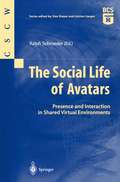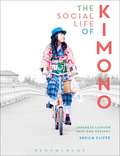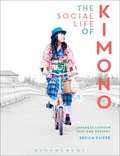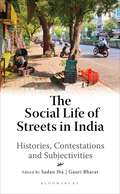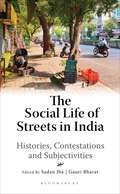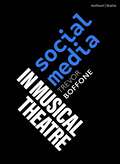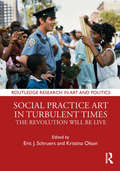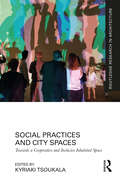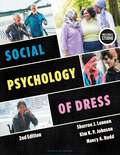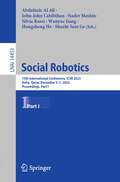- Table View
- List View
The Social Life of Avatars: Presence and Interaction in Shared Virtual Environments (Computer Supported Cooperative Work)
by RalphSchroederVirtual reality (VR) technology has been developed commercially since the early 1990s [1]. Yet it is only with the growth of the Internet and other high-bandwidth links that VR systems have increasingly become networked to allow users to share the same virtual environment (VE). Shared YEs raise a number of interesting questions: what is the difference between face-to-face interaction and interaction between persons inside YEs? How does the appearance of the "avatar" - as the graphical representation of the user has become known - change the nature of interaction? And what governs the formation of virtual communities? This volume brings together contributions from social scientists and computer scientists who have conducted research on social interaction in various types of YEs. Two previous volumes in this CSCW book series [2, 3] have examined related aspects of research on YEs - social navigation and collaboration - although they do not always deal with VRIVEs in the sense that it is used here (see the definition in Chapter 1). The aim of this volume is to explore how people interact with each other in computer-generated virtual worlds.
The Social Life of Kimono: Japanese Fashion Past and Present (Dress, Body, Culture)
by Sheila CliffeThe kimono is an iconic garment with a history as rich and colourful as the textiles from which it is crafted. Deeply associated with Japanese culture both past and present, it has often been thought of as a highly gendered, rigidly traditional and unchanging national costume. This book challenges that perception, revealing the nuanced meanings and messages behind the kimono from the point of view of its wearers and producers, many of whom – both men and women – see the garment as a vehicle for self-expression. Taking a material culture approach, The Social Life of Kimono is the first study to combine the history of the kimono as a fashionable garment with an in-depth exploration of its multifaceted role today on both the street and the catwalk. Through case studies covering historical advertising campaigns, fashion magazines, interviews with contemporary kimono designers, large scale and small craft producers, and consumers who choose to wear them, The Social Life of Kimono gives a unique insight into making and meaning of this complex garment.
The Social Life of Kimono: Japanese Fashion Past and Present (Dress, Body, Culture)
by Sheila CliffeThe kimono is an iconic garment with a history as rich and colourful as the textiles from which it is crafted. Deeply associated with Japanese culture both past and present, it has often been thought of as a highly gendered, rigidly traditional and unchanging national costume. This book challenges that perception, revealing the nuanced meanings and messages behind the kimono from the point of view of its wearers and producers, many of whom – both men and women – see the garment as a vehicle for self-expression. Taking a material culture approach, The Social Life of Kimono is the first study to combine the history of the kimono as a fashionable garment with an in-depth exploration of its multifaceted role today on both the street and the catwalk. Through case studies covering historical advertising campaigns, fashion magazines, interviews with contemporary kimono designers, large scale and small craft producers, and consumers who choose to wear them, The Social Life of Kimono gives a unique insight into making and meaning of this complex garment.
The Social Life of Streets in India: Histories, Contestations and Subjectivities
by Sadan Jha Gauri BharatStreets are places that stimulate activities, interactions, behaviours and, by extension, controls. Yet, within the built environment discourse, the street is first and foremost conceptualised as a mute backdrop to movement-vehicular or pedestrian. The Covid-19 pandemic brought renewed focus on the street as the space of networks, flows and mobilities as the 'lockdown' was the preferred mode of controlling the spread of the disease.The Social Life of Streets in India: Histories, Contestations and Subjectivities endeavours to understand the complexities of social dynamics of streets in relation to spatiality and materiality in the Indian milieu. It draws from a diverse body of scholarship and varied disciplinary leanings and engages with three broad strands: historical aspects of streets, the physicality of street as a built environment and social science discourse mediated through anthropology, urban geography, social theory and urban studies.Further the volume deliberates on questions such as: How do we look at streets and, in particular, how do we document and conceptualise streets in the Indian context that highlights the particularities of South Asian milieus? Is the street public? Is it merely a physical space? How does the street in its physicality and in its built form enter or respond to the metaphorical, the literary, the methodological and the social?
The Social Life of Streets in India: Histories, Contestations and Subjectivities
by Sadan Jha Gauri BharatStreets are places that stimulate activities, interactions, behaviours and, by extension, controls. Yet, within the built environment discourse, the street is first and foremost conceptualised as a mute backdrop to movement-vehicular or pedestrian. The Covid-19 pandemic brought renewed focus on the street as the space of networks, flows and mobilities as the 'lockdown' was the preferred mode of controlling the spread of the disease.The Social Life of Streets in India: Histories, Contestations and Subjectivities endeavours to understand the complexities of social dynamics of streets in relation to spatiality and materiality in the Indian milieu. It draws from a diverse body of scholarship and varied disciplinary leanings and engages with three broad strands: historical aspects of streets, the physicality of street as a built environment and social science discourse mediated through anthropology, urban geography, social theory and urban studies.Further the volume deliberates on questions such as: How do we look at streets and, in particular, how do we document and conceptualise streets in the Indian context that highlights the particularities of South Asian milieus? Is the street public? Is it merely a physical space? How does the street in its physicality and in its built form enter or respond to the metaphorical, the literary, the methodological and the social?
Social Media and the Contemporary City
by Eric Sauda Ginette Wessel Alireza KarduniThe widespread adoption of smartphones has led to an explosion of mobile social media data, more than a billion messages per day that continuously track location, content, and time. Social Media in the Contemporary City focuses on the effects of social media on local communities and urban space in a variety of political and economic settings related to social activism, informal economic activity, public art, and global extremism. The book covers events ranging from Banksy art installations, mobile food trucks, and underground restaurants, to a Black Lives Matter protest, the Christchurch mosque shootings, and the Pulse nightclub shooting. The interplay between urban space, local community, and social media in each case study requires diverse methodologies that are both computational (i.e. machine learning, social network analysis, and natural language processing) and ethnographic (i.e. semi-structured interviews, thematic analysis, and site analysis). The book views social media not as a replacement for the local community or urban space but rather as a translation of the uses and meanings of all three realms. The book will be of interest to students, researchers, and instructors in a number of disciplines including urban design/planning, media studies, geography, and communications.
Social Media and the Contemporary City
by Eric Sauda Ginette Wessel Alireza KarduniThe widespread adoption of smartphones has led to an explosion of mobile social media data, more than a billion messages per day that continuously track location, content, and time. Social Media in the Contemporary City focuses on the effects of social media on local communities and urban space in a variety of political and economic settings related to social activism, informal economic activity, public art, and global extremism. The book covers events ranging from Banksy art installations, mobile food trucks, and underground restaurants, to a Black Lives Matter protest, the Christchurch mosque shootings, and the Pulse nightclub shooting. The interplay between urban space, local community, and social media in each case study requires diverse methodologies that are both computational (i.e. machine learning, social network analysis, and natural language processing) and ethnographic (i.e. semi-structured interviews, thematic analysis, and site analysis). The book views social media not as a replacement for the local community or urban space but rather as a translation of the uses and meanings of all three realms. The book will be of interest to students, researchers, and instructors in a number of disciplines including urban design/planning, media studies, geography, and communications.
Social Media for Fashion Marketing: Storytelling in a Digital World
by Wendy K. BendoniSocial Media for Fashion Marketing uses cutting edge case studies and detailed interviews to show how the business of fashion is changing in the digital landscape. Bendoni (@BendoniStyle) also considers the psychological impact of being a hyper-connected consumer and the generational gaps in social media communication. Using academic research, alongside her 25 years of fashion marketing experience, Bendoni offers a clear picture of the changing narrative of storytelling, social confirmation, digital nesting and how to use data to shape a brand's online presence.With practical and critical thinking activities to hone your skills into professional practice, this is the ultimate guide to social marketing, promotion, SEO, branding and communication.Featured topics- Rules of Digital Storytelling- Rethinking Gamification- Strategic Digital Marketing- The Role of Citizen Journalists- The Social Media Looking Glass- World of Influencer Marketing- Visual Consumption Economy- Global Perspective of Social Media
Social Media for Fashion Marketing: Storytelling in a Digital World
by Wendy K. BendoniSocial Media for Fashion Marketing uses cutting edge case studies and detailed interviews to show how the business of fashion is changing in the digital landscape. Bendoni (@BendoniStyle) also considers the psychological impact of being a hyper-connected consumer and the generational gaps in social media communication. Using academic research, alongside her 25 years of fashion marketing experience, Bendoni offers a clear picture of the changing narrative of storytelling, social confirmation, digital nesting and how to use data to shape a brand's online presence.With practical and critical thinking activities to hone your skills into professional practice, this is the ultimate guide to social marketing, promotion, SEO, branding and communication.Featured topics- Rules of Digital Storytelling- Rethinking Gamification- Strategic Digital Marketing- The Role of Citizen Journalists- The Social Media Looking Glass- World of Influencer Marketing- Visual Consumption Economy- Global Perspective of Social Media
Social Media in Musical Theatre (Topics in Musical Theatre)
by Trevor BoffoneThis book introduces readers to the widespread phenomenon of how social media platforms such as YouTube, Twitter, and TikTok become an extension of long-standing aspects of musical theatre engagement. Although casual observers may dismiss social media's import, social media has revolutionized the field of musical theatre since the early days of Web 2.0 with spaces such as AOL, LiveJournal, and Myspace. Now, as social media continues to grow in relevance, the nuanced ways in which digital platforms influence musical culture remain ripe for study. Social Media in Musical Theatre moves beyond viewing social media merely as a passing fad or a space free from critical engagement. Rather, this volume takes a serious look at the critical role social media play in musicals, thus challenging how social media users and musical theatre-makers alike approach digital spaces. This book introduces the relationship between musical theatre and social media in the 21st century as well as methods to study social media's influence on musicals through three in-depth case studies organized around marketing on YouTube, fan engagement on Twitter, and new musical development on TikTok.
Social Media in Musical Theatre (Topics in Musical Theatre)
by Trevor BoffoneThis book introduces readers to the widespread phenomenon of how social media platforms such as YouTube, Twitter, and TikTok become an extension of long-standing aspects of musical theatre engagement. Although casual observers may dismiss social media's import, social media has revolutionized the field of musical theatre since the early days of Web 2.0 with spaces such as AOL, LiveJournal, and Myspace. Now, as social media continues to grow in relevance, the nuanced ways in which digital platforms influence musical culture remain ripe for study. Social Media in Musical Theatre moves beyond viewing social media merely as a passing fad or a space free from critical engagement. Rather, this volume takes a serious look at the critical role social media play in musicals, thus challenging how social media users and musical theatre-makers alike approach digital spaces. This book introduces the relationship between musical theatre and social media in the 21st century as well as methods to study social media's influence on musicals through three in-depth case studies organized around marketing on YouTube, fan engagement on Twitter, and new musical development on TikTok.
Social-Media und Museum: Wie digitale Bilder und ästhetische Praktiken die Kunsterfahrung verändern (Edition Museum #84)
by Sarah Maria UllrichWas passiert, wenn Besucher*innen von Kunstmuseen die Exponate der Ausstellungsräume fotografieren und die bildlichen Aufnahmen auf Social-Media-Plattformen neu kontextualisieren? Sarah Maria Ullrich zeigt anhand dichter ethnografischer Beschreibungen, dass diese vermeintlich banalen Praktiken im Kern eines vielschichtigen Spannungsfelds stehen, in dem sich nichts weniger als die Frage verhandelt, wie digitale Medien die moderne Museumserfahrung verändern. Sie illustriert, wie mediale Visualisierungstechniken als neue Formen des Widerstands im Kontext gesellschaftspolitischer Aushandlungsprozesse fungieren und damit nicht zuletzt auch die Deutungshoheit etablierter musealer Institutionen ins Wanken bringen.
The Social Neuroscience of Intergroup Relations: Prejudice, can we cure it?
by Sylvia TerbeckThe Social Neuroscience of Intergroup Relations; Prejudice can we cure it?” is a highly interdisciplinary book. It includes latest theories and research from: Social Psychology, Ethics, Psychopharmacology, as well as Social Neuroscience. The book is also based on the author’s team research. The book describes experimental studies which have suggested that fear of the out-group might play a role in prejudice. Amongst others, one experiment that received large media coverage will be illustrated; a study which found that the drug propranolol reduced racial bias. However, is there a “cure” for prejudice? But even if there were biological methods to reduce prejudice are there not ethical and medical problems associated with this? However, we are our brain; thus not only soul searching, but also a drug can change the core of a person.
Social Photography: Make All Your Smartphone Photos One in a Billion
by Daniela BowkerHot photo apps come and go, but the practice of shooting and sharing is universal and is now a fundamental part of the way that we communicate with each other. Photos aren't printed on paper anymore - they are displayed on screens; and everywhere they are shown, the viewer is invited to like or share. Social Photography will show you how to create photos that will be clicked on, liked, shared, and - if you want - go viral. A must-read for anyone who takes their online presence seriously, this book will show you how to give your photos a fresh look, give you hundreds of posing and shooting ideas, and let you share your life's most exciting moments wider than ever before.
Social Practice Art in Turbulent Times: The Revolution Will Be Live (Routledge Research in Art and Politics)
by Kristina Olson Eric J. SchruersThis volume is an anthology of current groundbreaking research on social practice art. Contributing scholars provide a variety of assessments of recent projects as well as earlier precedents, define approaches to art production, and provide crucial political context. The topics and art projects covered, many of which the authors have experienced firsthand, represent the work of innovative artists whose creative practice is utilized to engage audience members as active participants in effecting social and political change. Chapters are divided into four parts that cover history, specific examples, global perspectives, and critical analysis.
Social Practice Art in Turbulent Times: The Revolution Will Be Live (Routledge Research in Art and Politics)
by Eric J. Schruers Kristina OlsonThis volume is an anthology of current groundbreaking research on social practice art. Contributing scholars provide a variety of assessments of recent projects as well as earlier precedents, define approaches to art production, and provide crucial political context. The topics and art projects covered, many of which the authors have experienced firsthand, represent the work of innovative artists whose creative practice is utilized to engage audience members as active participants in effecting social and political change. Chapters are divided into four parts that cover history, specific examples, global perspectives, and critical analysis.
Social Practices and City Spaces: Towards a Cooperative and Inclusive Inhabited Space (Routledge Research in Architecture)
by Kyriaki TsoukalaThis book examines the relationship between social practices and built space, focusing on current cooperative/participative and posthuman approaches to its production and management. From a social-cultural-and-ecological perspective, it explores the modes of engagement of all factors in the constitutional processes of inhabited space. Throughout this interdisciplinary collection, built space is reconsidered in the light of other schools of thought such as philosophy, anthropology, social sciences and political theories and practices. It covers new ground at conceptual, epistemic and methodological levels, focusing on inhabited space from within the framework of globalisation, biopolitics, cultural changes, environmental crisis and new technologies. Organised into three parts, Parts 1 and 2 focus on the role of architects in the emergence of a new ethos for habitation, as well as the modalities of the inclusion of differences in design, discussing the importance of participation and narrative at a theoretical and practical level in architecture. In the third part, the chapters delve into questions regarding the intersection of design, ecology and technoscience in a posthuman approach, which might support the inclusion of differences in design and the emergence of a new environmental ethos. Providing a stimulating landscape of arguments and challenges to new readings of architecture, society and the environment, this book will be of interest to researchers, students and professionals of architecture, urban planning, anthropology and philosophy.
Social Practices and City Spaces: Towards a Cooperative and Inclusive Inhabited Space (Routledge Research in Architecture)
This book examines the relationship between social practices and built space, focusing on current cooperative/participative and posthuman approaches to its production and management. From a social-cultural-and-ecological perspective, it explores the modes of engagement of all factors in the constitutional processes of inhabited space. Throughout this interdisciplinary collection, built space is reconsidered in the light of other schools of thought such as philosophy, anthropology, social sciences and political theories and practices. It covers new ground at conceptual, epistemic and methodological levels, focusing on inhabited space from within the framework of globalisation, biopolitics, cultural changes, environmental crisis and new technologies. Organised into three parts, Parts 1 and 2 focus on the role of architects in the emergence of a new ethos for habitation, as well as the modalities of the inclusion of differences in design, discussing the importance of participation and narrative at a theoretical and practical level in architecture. In the third part, the chapters delve into questions regarding the intersection of design, ecology and technoscience in a posthuman approach, which might support the inclusion of differences in design and the emergence of a new environmental ethos. Providing a stimulating landscape of arguments and challenges to new readings of architecture, society and the environment, this book will be of interest to researchers, students and professionals of architecture, urban planning, anthropology and philosophy.
Social Psychology of Dress: - with STUDIO
by Sharron J. Lennon Kim K. Johnson Nancy A. RuddSocial Psychology of Dress presents and explains the major theories and concepts that are important to understanding relationships between dress and human behavior. These concepts and theories are derived from such disciplines as sociology, psychology, anthropology, communication, and textiles and clothing. Information presented will provide summaries of empirical research, as well as examples from current events or popular culture. The book provides a broad-based and inclusive discussion of the social psychology of dress, including: - The study of dress and how to do it- Cultural topics such as cultural patterns including technology, cultural complexity, normative order, aesthetics, hygiene, ethnicity, ritual- Societal topics such as family, economy-occupation, social organizations and sports, fraternal organizations - Individual-focused theories on deviance, personality variables, self, values, body image and social cognition- Coverage of key theories related to dress and identity provide a strong theoretical foundation for further researchUnique chapter features bring in industry application and current events. The end-of-chapter summaries, discussion questions and activities give students opportunities to study and research dress.Teaching resources including an instructor's guide, test bank and PowerPoint presentations with full-color versions of images from the textbook.Social Psychology of Dress STUDIO- Study smarter with self-quizzes featuring scored results and personalized study tips- Review concepts with flashcards of essential vocabulary- Download worksheets to complete chapter activitiesPLEASE NOTE: Purchasing or renting this ISBN does not include access to the STUDIO resources that accompany this text. To receive free access to the STUDIO content with new copies of this book, please refer to the book + STUDIO access card bundle ISBN 9781501330711.
Social Psychology of Dress: - with STUDIO
by Sharron J. Lennon Kim K. Johnson Nancy A. RuddSocial Psychology of Dress, 2nd Edition presents and explains the major theories and concepts of human behavior relating to dress, drawing from the social science fields of psychology, sociology, and anthropology. The text positions dress as a process in which individual preferences, membership in social groups, and cultural awareness all impact choices about attire and appearance. Using empirical data and examples from current events and popular culture, the authors define dress, present its origins and functions, and discuss research methods for dress. They also explore the relationships between dress and topics including social perception, impression formation, identity, cultural patterns and rituals, and body image. Box features highlighting applications to the fashion industry, end-of-chapter summaries, and discussion questions to further engage students in their study of dress. New to this Edition: -New Dress Research in the News, Application to Consumer Behavior, and Social Media Application features and updated Dress in the News features addressing contemporary topics such as cultural appropriation, workplace discrimination, and advocacy for racial inclusivity -Increased focus on diverse cultural influences-Coverage of current industry trends including new research findings, smart clothing, and the body positivity movement -Discussion of the Covid-19 pandemic through examples and case studies STUDIO Features Include: -Study smarter with self-quizzes featuring scored results and personalized study tips -Review concepts with flashcards of essential vocabulary Instructor Resources-Instructor's Guide provides suggestions for planning the course and using the text in the classroom, supplemental assignments, and lecture notes-Test Bank includes sample test questions for each chapter -PowerPoint® presentations include images from the book and provide a framework for lecture and discussion-In-class activities stimulate student engagement with course material -Online chat activities encourage student participation and provide creative alternatives for content delivery
The Social (Re)Production of Architecture: Politics, Values and Actions in Contemporary Practice
by Doina Petrescu Kim TrogalThe Social (Re)Production of Architecture brings the debates of the ‘right to the city’ into today’s context of ecological, economic and social crises. Building on the 1970s’ discussions about the ‘production of space’, which French sociologist Henri Lefebvre considered a civic right, the authors question who has the right to make space, and explore the kinds of relations that are produced in the process. In the emerging post-capitalist era, this book addresses urgent social and ecological imperatives for change and opens up questions around architecture’s engagement with new forms of organization and practice. The book asks what (new) kinds of ‘social’ can architecture (re)produce, and what kinds of politics, values and actions are needed. The book features 24 interdisciplinary essays written by leading theorists and practitioners including social thinkers, economic theorists, architects, educators, urban curators, feminists, artists and activists from different generations and global contexts. The essays discuss the diverse, global locations with work taking different and specific forms in these different contexts. A cutting-edge, critical text which rethinks both practice and theory in the light of recent crises, making it key reading for students, academics and practitioners.
The Social (Re)Production of Architecture: Politics, Values and Actions in Contemporary Practice
by Doina Petrescu Kim TrogalThe Social (Re)Production of Architecture brings the debates of the ‘right to the city’ into today’s context of ecological, economic and social crises. Building on the 1970s’ discussions about the ‘production of space’, which French sociologist Henri Lefebvre considered a civic right, the authors question who has the right to make space, and explore the kinds of relations that are produced in the process. In the emerging post-capitalist era, this book addresses urgent social and ecological imperatives for change and opens up questions around architecture’s engagement with new forms of organization and practice. The book asks what (new) kinds of ‘social’ can architecture (re)produce, and what kinds of politics, values and actions are needed. The book features 24 interdisciplinary essays written by leading theorists and practitioners including social thinkers, economic theorists, architects, educators, urban curators, feminists, artists and activists from different generations and global contexts. The essays discuss the diverse, global locations with work taking different and specific forms in these different contexts. A cutting-edge, critical text which rethinks both practice and theory in the light of recent crises, making it key reading for students, academics and practitioners.
Social Responsibility in the Global Apparel Industry
by Marsha A. Dickson Suzanne Loker Molly EckmanGlobalization has dramatically changed the way business is conducted in the apparel manufacturing industry, particularly with respect to social responsibility in the design, production, and sourcing of products. Social Responsibility in the Global Apparel Industry combines an introduction to social and environmental issues in apparel manufacturing with an analysis of how corporate strategy and decisions made throughout the global supply chain can increase social responsibility. Readers learn how leading apparel and footwear brands and retailers attempt to solve complex problems including child labor, harassment and abuse, discrimination, excessive hours of work, low wages, poor factory health and safety, and negative impacts on the environment. Drawing on their research and industry experience, the authors prepare the next generation of industry professionals to change the apparel industry from the inside out by instilling within them awareness, knowledge, and passion.
Social Robotics: 15th International Conference, ICSR 2023, Doha, Qatar, December 3–7, 2023, Proceedings, Part I (Lecture Notes in Computer Science #14453)
by Abdulaziz Al Ali John-John Cabibihan Nader Meskin Silvia Rossi Wanyue Jiang Hongsheng He Shuzhi Sam GeThe two-volume set LNAI 14453 and 14454 constitutes the refereed post-conference proceedings of the 15th International Conference on Social Robotics, ICSR 2023, held in Doha, Qatar, during December 4–7, 2023. The 68 revised full papers presented in these proceedings were carefully reviewed and selected from 83 submissions. They deal with topics around the interaction between humans and intelligent robots and on the integration of robots into the fabric of society. This year the special topic is "Human-Robot Collaboration: Sea; Air; Land; Space and Cyberspace”, focusing on all physical and cyber-physical domains where humans and robots collaborate.
Social Robotics: 15th International Conference, ICSR 2023, Doha, Qatar, December 3–7, 2023, Proceedings, Part II (Lecture Notes in Computer Science #14454)
by Abdulaziz Al Ali John-John Cabibihan Nader Meskin Silvia Rossi Wanyue Jiang Hongsheng He Shuzhi Sam GeThe two-volume set LNAI 14453 and 14454 constitutes the refereed post-conference proceedings of the 15th International Conference on Social Robotics, ICSR 2023, held in Doha, Qatar, during December 4–7, 2023. The 68 revised full papers presented in these proceedings were carefully reviewed and selected from 83 submissions. They deal with topics around the interaction between humans and intelligent robots and on the integration of robots into the fabric of society. This year the special topic is "Human-Robot Collaboration: Sea; Air; Land; Space and Cyberspace”, focusing on all physical and cyber-physical domains where humans and robots collaborate.
